How to choose an inverter for a heating boiler: selection criteria + review of reliable models
Many modern heating systems are controlled automatically and require a constant supply of electricity to operate correctly.If there are regular power outages, experts recommend purchasing a backup generator. When the absence of electricity is rare and does not last long, it is enough to install a progressive inverter for the heating boiler.
It converts the direct current coming from the battery into alternating current and allows the heating equipment to fully function for a certain time even in the absence of electricity. Let's take a closer look at the main characteristics of the device.
The content of the article:
General characteristics of the device
An inverter is primarily a DC to AC converter. In parallel, it changes the transmission amplitude and generates an output signal of a suitable frequency. The device itself cannot charge the battery and monitor its current capacity.
Many modern manufacturers equip their products with accompanying elements, additional chargers and a control control unit. Such models are already classified as uninterruptible power supplies (UPS) and have the ability to solve a wider range of problems.
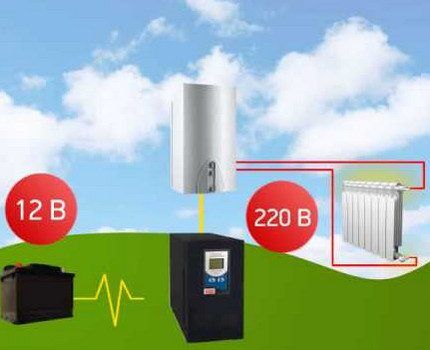
Integrated into the heating system, they monitor the presence of current in the network and, in the event of a sudden emergency shutdown of the electrics, maintain full operation of the equipment for some time.
In this way, preventing potential freezing of water in pipes and radiators (in winter), breakdown of individual parts of the system and other unpleasant problems.
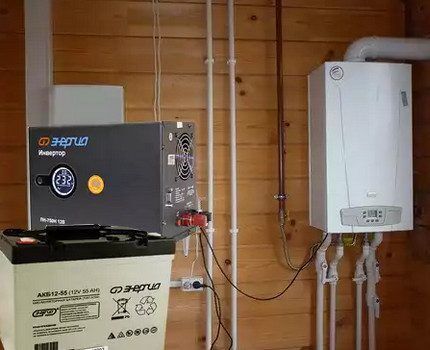
Simple, low-cost products perform only one direct function - providing the boiler with energy to operate for a certain amount of time. Complex progressive modules have expanded potential.
In addition to their main mission, they act as stabilizers and equalize the voltage in the system, thus protecting equipment from excess load and failure.
Complete set of inverter energy sources
In the modern market of household related equipment, inverters are presented in several versions. Some brands produce extremely simple units that work only as voltage converters.
The rechargeable battery is not initially included in the package of such modules, but its connection is allowed by the design, and the user can purchase this element separately in the future.
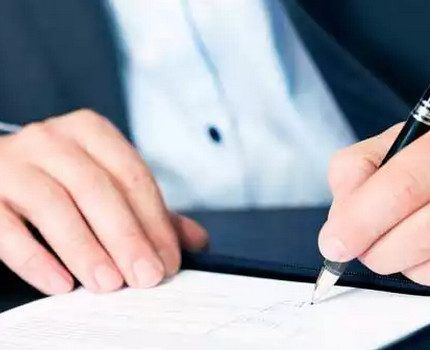
Some types of inverters have a built-in battery of a certain, usually small capacity, but increasing its volume using external additional batteries is not possible.
Devices of this type keep the heating equipment operating for a short time and mostly serve to enable the owner to correctly disconnect the system from the power supply in an emergency.
A basic battery is built into universal units. Expanding the capacity of the device is carried out by adding external batteries. In this way, the operating time of the device is increased from several hours to several days.
Product design features
The inverter has optimal dimensions and is shaped like a parallelepiped. Placed on the floor in close proximity to the boiler or mounted on the wall (if provided for by the design features of the purchased model).
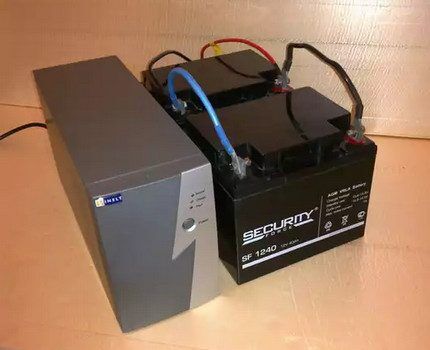
In advanced models, a control unit with a boiler switching system and a basic battery are located inside the housing. The first node monitors the availability of energy and promptly switches the equipment to autonomous operation if interruptions in the supply of resources occur in the central network.
The second unit (battery) provides power to all electronic elements of the boiler for the entire period of power outage or until the charge runs out.
How are devices classified?
Almost all inverter devices are components of a UPS (uninterruptible power supply) and perform the same function - convert direct current from the battery into alternating current.
In the event of an unexpected power outage, the backup power supply system is activated, and the heating equipment instantly switches to autonomous operation. This allows you to maintain the full functioning of the heating over a certain period of time - from several hours to several days.
According to the operating principle, the devices are divided into three types:
- Off-line (backup);
- Line-interactive (line-interactive);
- On-line (double conversion).
Each type of device has its own specific characteristics and capabilities that allow it to solve diverse problems. After thoroughly studying the parameters of all three devices, choosing the best option for yourself will not be difficult.
Operating principle of Off-line units
The off-line model has a simple design and is considered a backup model. When the electrical network operates in standard mode and demonstrates stability, and the voltage does not “jump” between extreme values, the device “sleeps” and does not participate in the operation of the household heating system.
If the current level drops to 175 V, the unit switches heating boiler for recharge from a battery. As soon as the situation is restored, the inverter UPS reconnects the heating equipment back to the main network.
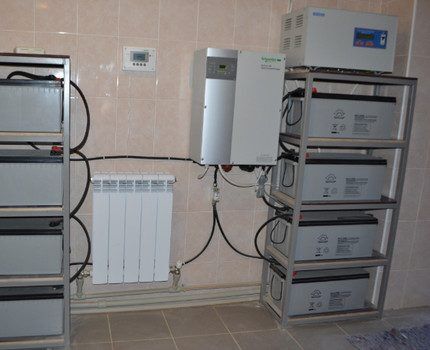
Each transition from the main power source to an autonomous one and back lasts no more than 10-15 seconds and does not in any way affect the functionality of the heating equipment.
The operating range of most off-line converters lies in the range of 170-270 V.
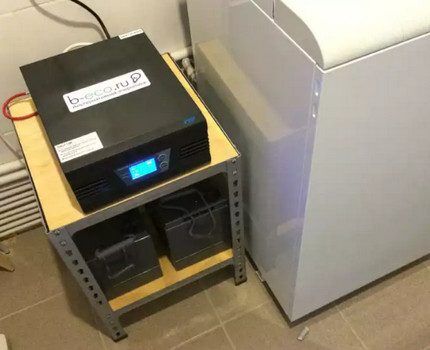
With a constantly “jumping” voltage, switching from the main system to the autonomous system occurs too often and leads to rapid wear of the batteries and the device itself. Stabilizers are not included in the device, so when connected, both at the input and output, the mains voltage does not change.
Therefore, we recommend reading our article on how to choose a voltage stabilizer for a heating boiler. Read more - read Further.
Depending on the manufacturer and model, backup appliances can effectively handle electrical equipment ranging from 300 to 3,500 watts. Some products provide cyclic operation and the ability to prevent communication parts of the heating system from freezing for a day or more.
How do Line-interactive modules behave?
The Line-interactive device is a switching type device and is considered the best option for universal equipment.Structurally, the product consists of an off-line source, a converter, a switching relay and a low-frequency stabilizer device.
In the standard operating mode of the unit, the heating equipment consumes the resource of the central energy main. The output voltage is controlled by a stabilizer and special filters (for some models), smoothing out noise and neutralizing interference from the network to which the boiler itself is connected.
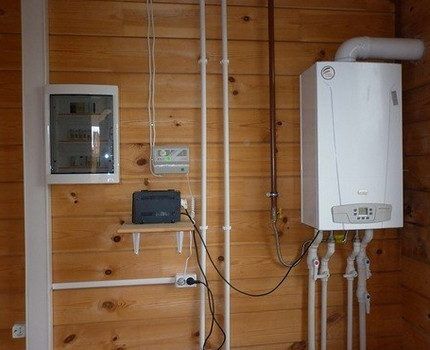
Line-interactive type units supply electrical appliances with useful energy for a very short period of time (no more than 20 minutes).
To provide heating boilers with a resource, they use not ordinary liners, but improved products with an expansion function, which provide for the connection of an additional external battery. Such devices can keep the boiler operating for a longer time (up to 10 hours depending on the manufacturer).
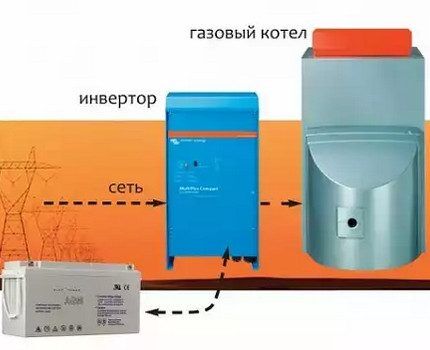
The built-in current stabilizer allows the equipment to operate correctly without switching to a battery over an extended voltage range. The device provides backup power from the battery and equalizes the mains voltage. The disadvantages of the products include the inability to correct the flow frequency of the current and minimal smoothing of the sinusoid (no more than 20%).
Features of on-line devices
Online devices operate in constant mode.
The conventional diagram for connecting heating equipment in this embodiment is constructed in the following sequence:
- central electrical network;
- inverter uninterruptible power supply;
- boiler.
The principle of operation of the device comes down to repeated transformation of the general parameters of the electrical network. At the first stage, when entering the inverter, the alternating voltage is converted into a stable equivalent with an indicator of 12 V.
Then the reverse maneuver occurs and at the output of the inverter apparatus the voltage turns into alternating voltage with a value of 220 V.
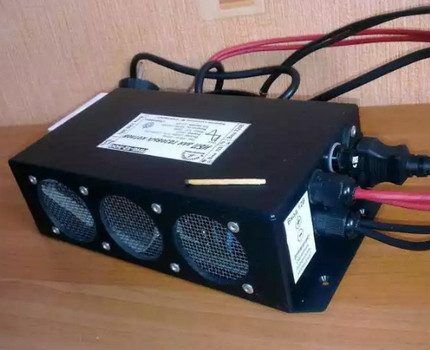
The main advantage of a system of this type is the provision of high-quality voltage to the power supply unit of the heating boiler. There are only two disadvantages: the high cost of conversion equipment and the low level of performance.
Advantages and disadvantages of equipment
The inverter is convenient because it is not tied to a specific type of DC voltage source. The unit can be powered using a regular car battery, a generator set with a simple signal rectification principle, or from UPS batteries.
If the module does not have a built-in charger, the owners will have to personally control the capacity level and the degree of discharge of the device.
Among the main advantages of the device:
- a wide range of models and the ability to select a product with an almost ideal output sinusoid;
- correct operation with all sources of rated voltage and direct current;
- reasonable cost compared to other similar units of similar power;
- no restrictions on increasing battery capacity and duration of autonomous operation.
Disadvantages include criteria such as:
- lack of control over the battery charging/discharging level;
- the response threshold setting is not subject to additional correction;
- the need to arrange an external communication circuit for automatic activation in the event of a power outage in a residential area;
- high cost of “sophisticated” modules with a wide range of capabilities.
The final choice of a suitable device is strictly individual. It all depends on how much the voltage “jumps” in the network, how often consumers are cut off from the supply of resources by the central electrical system, and how long they have to sit without power.
Basic rules for choosing a module
When planning to purchase an inverter for a boiler, you need to pay close attention to such parameters as:
- indicator of input voltage and current;
- output voltage level;
- degree of distortion of the output voltage sinusoid;
- actual conversion factor;
- total power output.
For household gas boilers, mainly use 12-220 inverter units. These units convert 12V DC battery voltage into 220V sine wave voltage with minimal distortion.

You can also acquire a more powerful combination of units (24-220 converter and 24 V battery), but you need to find out exactly what maximum input current the inverter is designed for.
Only after receiving this information should you start purchasing.
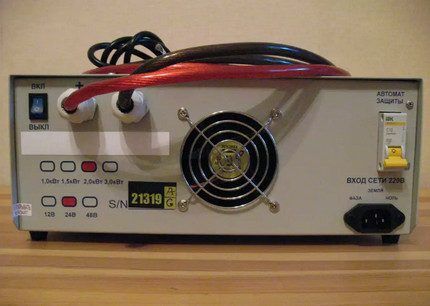
The controller and control unit of popular gas boilers usually consume power of about 150-200 W. Responsible for the correct circulation of the heating fluid in the system, circulation pump takes another 125-150 watts. To determine the required power of the inverter, these data must be added and multiplied by 2.5 to take into account the volume of starting current at the time of startup.
The finished numbers must be multiplied by 1.2 again to take into account some power reserve. Remember or write down the received data. When purchasing an inverter, make sure that the base power declared by the manufacturer certainly exceeds the calculated values.
List of popular models and manufacturers
There are many domestic and foreign companies, firms and organizations operating in the electrical engineering market segment. Some of them produce products under license, others develop their own technologies and offer customers unique, innovative and competitive products at a very reasonable price.
Device of the company ETK "Energia"
Inverter Energy PN-500 is an inexpensive, practical device that provides uninterrupted power supply for modern low-power boilers. Manufactured at the production facilities of ETK Energia, one of the leaders in the domestic electrical market.
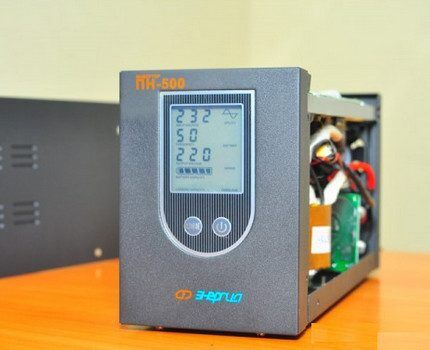
Connecting one basic battery to the device ensures full autonomous operation of the fuel boiler for 6-7 hours. If you connect a second battery, the operating time will double.
The unit produces a pure sine wave at the output, which helps preserve the expensive electronic “filling” of modern heating boilers. When the operation of the central electrical system returns to normal, the inverter automatically switches to voltage stabilization mode and protects the boiler from sudden power surges.
Device "Elim-Ukraine"
The Elim-Ukraine company has been operating in the electrical equipment market for more than 10 years and is respected by customers.
Devices produced under this brand have a switching power supply, eye-pleasing LED display and demonstrate an extremely high level of efficiency (up to 98%). Produces a pure sine wave signal without distortion or surge levels.
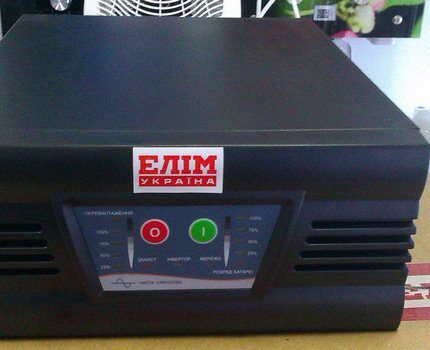
Equipped with protection against overheating, general overload and deep battery discharge.One of the expansion options allows you to connect an additional battery of any capacity to the equipment to maintain autonomous operation of the heating system even in the absence of voltage in the central main networks for a day or more.
Unit Rucelf UPI-400-12-EL
The Rucelf UPI-400-12-EL device belongs to the category of linear-interactive energy sources. It has a built-in stabilizer, which, even if there is a minimum mains voltage, equalizes the current flow without using the battery. This makes it possible to economically use the battery life without overloading and extending their service life.
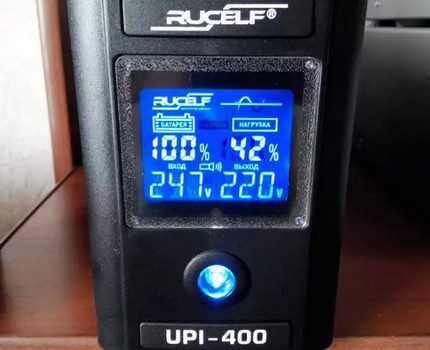
Reasonable cost is another characteristic feature of the products of the Russian company Rucelf.
Thanks to this, customers can create a full-fledged autonomous infrastructure to recharge heating systems during emergency power outages or power surges.
Conclusions and useful video on the topic
How to buy the right inverter and choose the optimal capacity battery for it. How to install equipment on the boiler and forget about electrical interruptions forever:

A detailed overview of the device, operating principles and functionality of the popular model of voltage inverter unit with a pure sine wave:

How does an inverter voltage converter that does not have a built-in battery inside the case behave:

Installing an inverter device on a heating boiler allows the heating system to function correctly during intense voltage surges and during a general blackout.The owners do not feel any inconvenience due to the lack of electricity and do not freeze if this unpleasant situation happens during the cold season.
In addition, the device protects communication elements from possible breakdowns caused by an unexpected blackout, and helps the equipment operate as long as possible and with maximum efficiency.
Already have experience using inverters for heating boilers? Please tell our readers which device you chose? What were you guided by? Are you satisfied with the device's performance? Leave your comments, share your experience, ask questions in the block below.




Selecting a good inverter for a boiler is not an easy task, as it seems at first glance. I chose and missed, I wanted to save money, but as they say, the miser pays twice. The boiler burned out from a power surge, or rather, the electronic board burned out, but the inverter remained as if nothing had happened. That's how I got there. Now, of course, I will not save, and I will choose carefully, albeit for a long time.
I also encountered this situation. I had an inverter and a stabilizer for a heating boiler, the seller advised me to take it. So, at the most crucial moment he did not save the boiler. During a thunderstorm, there was a power surge and the electronic board on the boiler burned out (probably this is their weakest point). The cost of the board is equal to half the cost of the entire boiler. And the inverter remains as it was. I bought it on my own, most likely I ran into a fake. It seems like this is their problem!